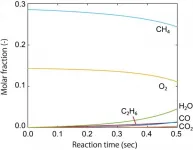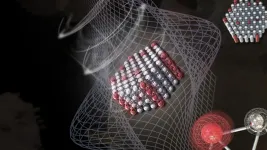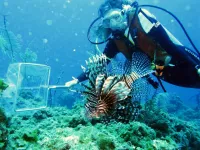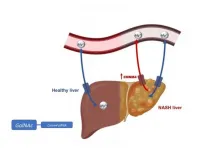(Press-News.org) CHAPEL HILL, North Carolina--UNC Lineberger Comprehensive Cancer Center researchers have successfully used an experimental safety switch, incorporated as part of a chimeric antigen receptor T-cell (CAR-T) therapy, a type of immunotherapy, to reduce the severity of treatment side effects that sometimes occur. This advance was seen in a patient enrolled in a clinical trial using CAR-T to treat refractory acute B-cell leukemia. It demonstrates a proof-of-principle for possible expanded use of CAR-T immunotherapy paired with the safety switch.
The researchers published their findings in the journal Blood as an ahead-of-print publication.
With CAR-T therapy, T-cells from a patient's immune system are modified in a manufacturing facility to express part of an antibody that can bind to a surface protein on cancer cells. The modified T-cells, after being infused back into the patient, seek out and attack cancer cells throughout the body. Patients with leukemia or lymphoma have experienced complete remission when treated with CAR-T therapy but sometimes experience toxicities, which can be life-threatening, due to inflammatory responses or nervous system toxicities caused by the modified T-cells.
When using standard forms of cancer therapies, including pills and infused drugs, doctors can interrupt or lower drug dosing to respond to treatment toxicities. With cell-based immunotherapies, this is not possible after the cells are infused. So UNC Lineberger researchers engineered T-cells to include a safety switch, called inducible caspase-9, or iC9, that can be activated if toxic side effects develop. Administration of the drug rimiducid "triggers" the switch to activate the expression of caspase-9, potentially leading to reduced severe side effects from the CAR-T therapy.
"Because of our active Cellular Immunotherapy Program at UNC Lineberger, we can engineer and generate various CAR-T cells for clinical trials. In this case, we have produced specialized CAR-T cells that could benefit patients by enhancing safety," said Matthew Foster, MD, lead author of the study and an associate professor in the UNC School of Medicine and a UNC Lineberger member. "With the assistance of our partner Bellicum Pharmaceuticals, we collaborated to use the safety switch-triggering drug rimiducid with cells manufactured at UNC Lineberger."
UNC Lineberger has enrolled patients in an ongoing early-phase clinical trial to determine whether a novel CAR-T therapy with the iC9 safety switch is safe and effective against relapsed or refractory B-cell acute lymphoblastic leukemia, a difficult to treat, fast-moving cancer that occurs frequently in children, adolescents and young adults.
One of the participants in the study, a 26-year-old woman, experienced a severe side effect -- immune effector cell-associated neurotoxicity syndrome (ICANS) -- after being infused with CAR-T. Her clinicians quickly reduced the severity of the side effects by administering the drug rimiducid to activate the iC9 safety switch. As intended, Foster said the safety switch reduced the number of circulating modified T-cells by nearly 60 percent within four hours and by more than 90 percent within 24 hours. The drug nearly eliminated the toxicities within one day.
"Even though this case study only documents an outcome in one patient, the fact that the drug was so successful so quickly gives us hope that it could have wider applications in a larger group of leukemia patients," said Gianpietro Dotti, MD, director of the UNC Lineberger Cellular Immunotherapy Program and professor of medicine at the UNC School of Medicine. "It should be noted that while rimiducid mitigated her toxicities, it also lowered the number of iC9 T cells fighting her cancer by 90 percent. But there seemed to be sufficient T-cells still circulating to maintain an anticancer response."
This trial is ongoing but the investigators will next explore the effects of lower doses of rimiducid in patients with less severe toxicity as it could be a way to intervene early and prevent severe toxicity.
"Given these results and the well-established high response rates in B-cell acute lymphoblastic leukemia patients receiving CAR-T cells, it is reasonable to have a high bar in 2021 and expect that we can achieve both safety and efficacy from such therapies," concluded Foster.
The investigators also see the potential to use CAR-T designed with the built-in safety switch to treat other cancers. "The ability to use a safety switch may also allow us to treat patients with solid tumors where there may be concern about the CAR-T cells affecting non-cancer tissue," said Jonathan Serody, MD, director of the UNC Lineberger Cellular Therapy Program. "In those instances, side effects can be eliminated by activating the safety switch."
INFORMATION:
Authors and Disclosures
In addition to Foster, Dotti and Serody, the paper's other authors are Barbara Savoldo, MD, PhD, Natalie Grover, MD, Paul Armistead, MD, James Coghill, MD, and John West, PhD, UNC Lineberger and UNC School of Medicine; Kaitlin Morrison, PhD, Catherine Cheng and Spencer Laing, UNC Lineberger; Faith Brianne Buchanan PAC, Winnie Lau, MD, and Clio Rubinos, MD, UNC School of Medicine; Robert Hagan, MD, PhD, UNC Marsico Lung Institute and UNC School of Medicine; Anastasia Ivanova, PhD, UNC Gillings School of Global Public Health; and Aaron Foster, PhD, Bellicum Pharmaceuticals.
The production of CAR-T was supported in part by the University Cancer Research Fund and by Bellicum Pharmaceuticals. Rimiducid was provided by Bellicum Pharmaceuticals.
Foster received research support from Bellicum Pharmaceuticals and Macrogenics as well as consulting fees from Macrogenics and Daiichi Sankyo. Savoldo received research support from Bellicum Pharmaceuticals, Bulebirdbio, Tessa Therapeutics and Cell Medica as well as consulting fees from Tessa Therapeutics. Grover received research support from Genentech and consulting fees from Tessa Therapeutics; she serves on the Advisory Board of Kite Pharmaceuticals. Foster is employed by Bellicum Pharmaceuticals. Serody received research support from Merck Inc., GlaxoSmithKline and Carisma Therapeutics as well as consulting fees from PIQUE Inc. Dotti received research support from Bellicum Pharmaceuticals and Tessa Therapeutics and consulting fees from Tessa Therapeutics.
The human genome contains roughly three million letters. On average, the genome sequences of any two people differ from each other by about one in every 1,000 letters. Yet different variants occur, from substituted letters to entire missing sections of DNA. Scientists from the Berlin Institute of Health (BIH) and the Regensburg Center for Interventional Immunology (RCI) have teamed up with Icelandic researchers to develop software that reliably and quickly identifies large deletions in ten-thousands of genomes simultaneously. The researchers have now published their findings in the journal Nature Communications.
The human genome contains roughly three million letters ...
Japanese researchers have developed a simulation method to theoretically estimate the performance of heterogeneous catalyst by combining first-principles calculation (1) and kinetic calculation techniques. Up to now, simulation studies mainly focused on a single or limited number of reaction pathways, and it was difficult to estimate the efficiency of a catalytic reaction without experimental information.
Atsushi Ishikawa, Senior Researcher, Center for Green Research on Energy and Environmental Materials, National Institute for Materials Science (NIMS), performed computation of reaction kinetic information from first-principles calculations based on quantum mechanics, and developed methods and programs to carry out kinetic simulations ...
The speed at which we produce facial expressions plays an important role in our ability to recognise emotions in others, according to new research at the University of Birmingham.
A team in the University's School of Psychology carried out research which showed that people tend to produce happy and angry expressions more rapidly, while sad expressions are produced more slowly.
The team found that our ability to form judgements about people's facial expressions has close links with the speeds at which those expressions are produced and is also closely related to the ways in which we would produce those expressions ourselves. The study is published in Emotion.
"Being able to recognise and interpret ...
Much like the Jedis in Star Wars use 'the force' to control objects from a distance, scientists can use light or 'optical force' to move very small particles.
The inventors of this ground-breaking laser technology, known as 'optical tweezers', were awarded the 2018 Nobel Prize in physics.
Optical tweezers are used in biology, medicine and materials science to assemble and manipulate nanoparticles such as gold atoms. However, the technology relies on a difference in the refractive properties of the trapped particle and the surrounding environment.
Now scientists have discovered a new technique that allows them to manipulate particles that have the same refractive ...
The vegan diet is on trend. How this type of diet affects health is the subject of scientific studies. In a new study from the German Federal Institute for Risk Assessment (BfR), the bone health of 36 vegans as well as 36 people following a mixed-food diet was determined with an ultrasound measurement of the heel bone. The result: on average, people following a vegan diet had lower ultrasound values compared to the other group. This indicates poorer bone health.
In the study, the scientists also determined biomarkers in blood and urine. This aims ...
Managing invasive species--not eliminating them altogether--is a better use of time and conservation resources in many cases, according to a study led by a University of Alberta biologist.
Every year, hundreds of introduced species cause billions of dollars in damage to ecosystems, agriculture and infrastructure in North America alone. The research, led by Stephanie Green, makes a case for working smarter, not harder, to temper the impact of destructive and widespread invasive species using a strategy called functional eradication.
"Rather than trying to completely eliminate invasive species that have spread over large areas, which is very ...
Typically, light emitted from standard lasers has a controllable degree of freedom (DoF) which may be polarisation or beam shape. By suitably manipulating a laser with the introduction of specialised optical components, an output with 2 DoFs, such as vector vortex beams with controllable polarisation and orbital angular momentum (OAM). The term 'vector' describes a structured change in the polarisation across the beam and 'vortex' describes the twisting of the phase in the beam (OAM), much like a twisting tornado. Transcending 2 DoFs from a laser was not possible. By exploiting ray-wave duality in a frequency-degenerate laser, ...
Being older, overweight and having low haemoglobin levels (fewer red blood cells) could increase a patient's risk of developing debilitating nerve damage following chemotherapy, a research team led by UNSW Sydney has revealed.
The researchers aimed to identify pre-treatment clinical and blood-based risk factors in patients who developed chemotherapy-induced peripheral neuropathy (CIPN) - nerve damage in peripheral body parts, like hands or feet, as a result of chemotherapy.
The study, published in JAMA Network Open recently, examined patients - mostly women - who received paclitaxel or oxaliplatin chemotherapy treatment, which are common treatments for breast, colorectal and gynaecological ...
In a colourful solution to a dangerous problem, Australian scientists are adapting a component from cutting-edge solar cells to design a rapid, light-based detection system for deadly toxins.
While use of chemical warfare agents like sulfur mustard - better known as mustard gas - is banned internationally, we do rely on other strictly-controlled chemicals for agriculture, industry and throughout our daily lives, including fumigants like methyl iodide, which is used to control insects and fungi. The wrong amounts or incorrect use of these fumigants can be harmful to people and degrade the ozone layer.
Because it's invisible and doesn't smell, it's hard to tell whether there are dangerous amounts of methyl iodide present, and until ...
An international team of researchers has identified the CNNM4 protein as a key regulator of magnesium in the liver and potential therapeutic target for non-alcoholic fatty liver disease, according to a study published in the Journal of Hepatology.
Non-alcoholic steatohepatitis, a form of fatty liver disease characterized by inflammation and liver fibrosis, is associated with obesity and has a worldwide prevalence of 1.7 billion people.
Unhealthy nutritional habits and dietary imbalances are recognized as causes of many diseases. Magnesium is widely available in both plant and animal foods; most vegetables, legumes, peas, beans, and nuts are rich in magnesium, as are some ...






